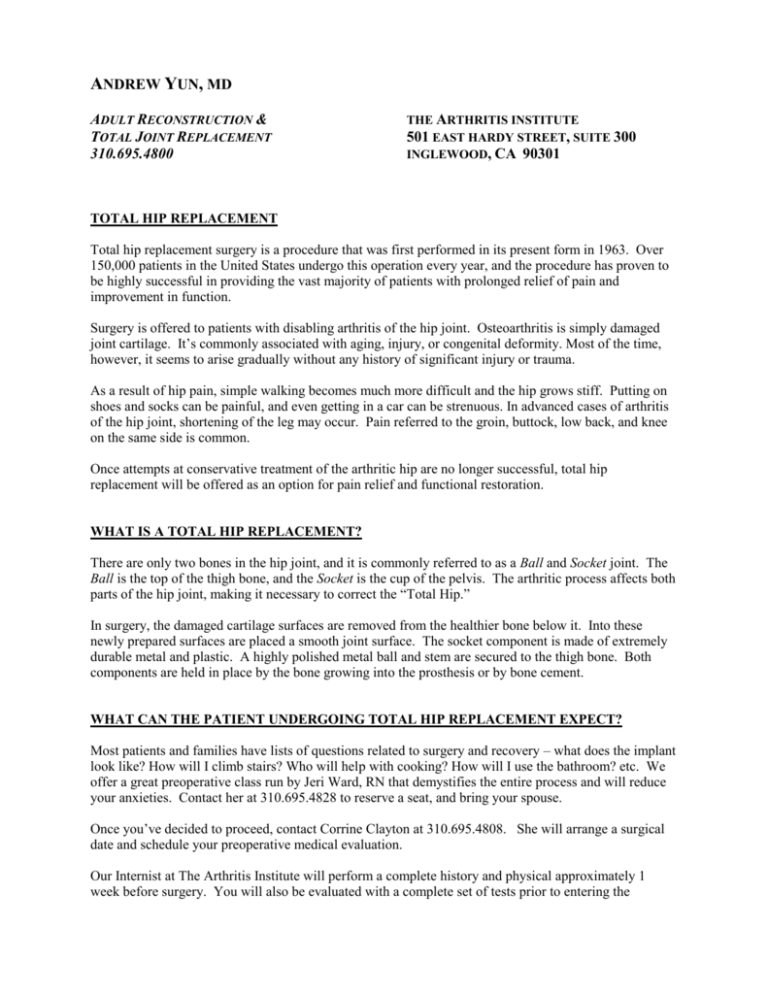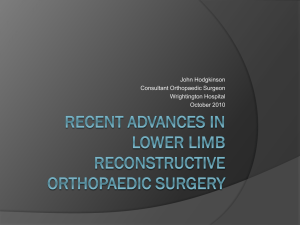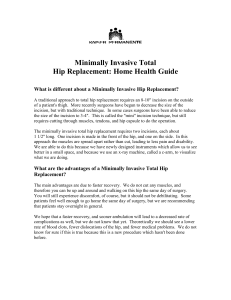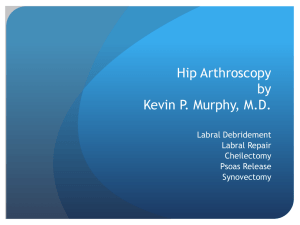Total Hip Replacement
advertisement

ANDREW YUN, MD ADULT RECONSTRUCTION & TOTAL JOINT REPLACEMENT 310.695.4800 THE ARTHRITIS INSTITUTE 501 EAST HARDY STREET, SUITE 300 INGLEWOOD, CA 90301 TOTAL HIP REPLACEMENT Total hip replacement surgery is a procedure that was first performed in its present form in 1963. Over 150,000 patients in the United States undergo this operation every year, and the procedure has proven to be highly successful in providing the vast majority of patients with prolonged relief of pain and improvement in function. Surgery is offered to patients with disabling arthritis of the hip joint. Osteoarthritis is simply damaged joint cartilage. It’s commonly associated with aging, injury, or congenital deformity. Most of the time, however, it seems to arise gradually without any history of significant injury or trauma. As a result of hip pain, simple walking becomes much more difficult and the hip grows stiff. Putting on shoes and socks can be painful, and even getting in a car can be strenuous. In advanced cases of arthritis of the hip joint, shortening of the leg may occur. Pain referred to the groin, buttock, low back, and knee on the same side is common. Once attempts at conservative treatment of the arthritic hip are no longer successful, total hip replacement will be offered as an option for pain relief and functional restoration. WHAT IS A TOTAL HIP REPLACEMENT? There are only two bones in the hip joint, and it is commonly referred to as a Ball and Socket joint. The Ball is the top of the thigh bone, and the Socket is the cup of the pelvis. The arthritic process affects both parts of the hip joint, making it necessary to correct the “Total Hip.” In surgery, the damaged cartilage surfaces are removed from the healthier bone below it. Into these newly prepared surfaces are placed a smooth joint surface. The socket component is made of extremely durable metal and plastic. A highly polished metal ball and stem are secured to the thigh bone. Both components are held in place by the bone growing into the prosthesis or by bone cement. WHAT CAN THE PATIENT UNDERGOING TOTAL HIP REPLACEMENT EXPECT? Most patients and families have lists of questions related to surgery and recovery – what does the implant look like? How will I climb stairs? Who will help with cooking? How will I use the bathroom? etc. We offer a great preoperative class run by Jeri Ward, RN that demystifies the entire process and will reduce your anxieties. Contact her at 310.695.4828 to reserve a seat, and bring your spouse. Once you’ve decided to proceed, contact Corrine Clayton at 310.695.4808. She will arrange a surgical date and schedule your preoperative medical evaluation. Our Internist at The Arthritis Institute will perform a complete history and physical approximately 1 week before surgery. You will also be evaluated with a complete set of tests prior to entering the hospital. This will include blood tests, urine and stool tests, EKG, chest x-rays and any other tests deemed necessary by the Internist or myself. If any of the tests demonstrate significant abnormality, a delay will take place until all of your problems have been corrected. You must be in satisfactory medical condition prior to this operation. An Anesthesiologist from The Arthritis Institute will also see you prior to surgery. He will review all appropriate options in order to provide the safest and most comfortable surgery. You may require a transfusion during hip replacement surgery. All attempts to keep the use of blood replacement to a minimum will be exercised. For most patients, it is possible to give blood prior to surgery for later use during the operation and afterwards. The operation itself takes about 2 hours and you will be brought to the recovery room after your surgery is completed. Please have your family let the office know where I can contact them after your surgery. POST OPERATIVE REGIMEN FOR TOTAL HIP REPLACEMENT The patient undergoing total hip replacement will have an intravenous line running for approximately 48 hours after surgery to provide fluids and antibiotics. A drain may be placed into the area of the hip during the operation and this will generally be removed the day after surgery. A urine tube will also be removed about the same time. Fluids will be started by mouth the day after surgery and your diet advanced over the next few days. Constipation lasting many days is not unusual after surgery. We will provide you with assistance should the need arise. Your leg will be supported in a sling to relax any muscle spasm and to take pressure off the incision. The nurses will be moving you to prevent pressure sensitive areas from developing. It is important that you take deep breaths and cough in order to keep your lungs clear; the nurses will help encourage you. Usually on the day after surgery you will be allowed to sit up at the bedside and, depending on how you feel, you will be allowed to stand at this point. You will generally begin walking on the 2 nd or 3rd day with a walker. You will be advanced to crutches or a cane depending on your progress and you will be discharged with them. An exercise program will be given to you by the physical therapist. These exercises are to be continued after your discharge from the hospital. You will be expected to demonstrate that you can care for yourself independently prior to discharge from the hospital. You will be expected to transfer in and out of bed unassisted, walk the circumference of the hospital with a cane or crutches, and climb stairs to the satisfaction of the physical therapist. In addition, your wound must be healed, without problems and you must not have a medical problem. The average length of stay for a patient undergoing total hip replacement is 3-6 days. When you are discharged, you will be given a prescription for pain medication and usually a coated aspirin. The veins in your leg may be tested before you go home and if a clot should occur, the Internist will prescribe an anticoagulant (blood thinning medication) for you to take for 6-12 weeks. THE FIRST WEEKS AFTER DISCHARGE FROM THE HOSPITAL During the initial month after discharge walking is encouraged with your cane or crutches to your tolerance, and it will be important for you to be active. Patients often feel fatigued during the first 4 weeks but rapidly gain strength soon thereafter. Attention to your precautions is especially critical during this time. Pain medication will be given to you upon your discharge, but should only be used if needed. You will return to our office 4 to 6 weeks after discharge from the hospital, and you need to call my office for this appointment. These appointments are usually scheduled before you are admitted, but you should call to confirm your appointment either while you are in the hospital or right after you get home. An X-ray of your hip will be taken when you see me for the first time after surgery. Special attention should be given to sitting in high chairs or sitting on pillows. Avoid reclining chairs. The reason for this is to prevent the hip from becoming too highly flexed which can dislocate the hip joint. An elevated toilet seat will also be given to you when you go home and you should use this. Lying on the operated hip should also be avoided during the 1st month at home as the incision will be sensitive. The physical therapist will instruct you as to which exercises you should be doing at home; if any of these exercises produce pain they should be avoided and you should contact my office. You may notice leg swelling or a feeling of difference in leg lengths. Sitting for long periods with the operated leg hanging down can produce significant swelling in the leg, so elevation is encouraged. Elastic stockings should be used if there is swelling present. If the swelling continues, you should lie down for 1 hour twice a day with your leg elevated. During surgery, we make every effort to minimize any difference in leg lengths. Even in the best cases, it may take the body a month or two to adapt to the new sensation. You will continue to limp and use a cane until your leg becomes strong again. Your energy needs to be directed to recovery, strengthening, and feeling better. Plan to take a break from work, driving and household chores for many weeks. You owe it to yourself. If there is excessive pain or any drainage from the wound or if you begin running a fever after discharge from the hospital, you should contact our office. THE FIRST YEAR AFTER HIP REPLACEMENT If your recovery is satisfactory at the time of your first return visit to my office, you will be able to walk without a cane, and additional exercises will be given to you. All of the hip precautions will be removed after 3 months. If your progress is good, you will be asked to return in 6 months and in one year for an Xray and examination. You will be seen annually after the first year unless you have any problems. Most patients experience dramatic relief of their preoperative pain and are consequently able to walk much better. Any tendency to tilt toward the operated side when walking should gradually disappear as recovery progresses. Strength, mobility, and endurance will continue to improve for up to a year. COMPLICATIONS OF HIP REPLACEMENT SURGERY As with any major operation, complications can occur. These potential problems fall into 3 major categories: 1. Medical Medical complications after surgery include, but are not limited to, heart and lung problems, blood clots and phlebitis in the operated leg. If a patient has a medical history of a particular problem, that condition may be aggravated by surgery. You will be thoroughly tested and examined by our Internist before surgery, and he or she will follow you during your hospitalization. Medical complications are for the most part uncommon, but you should be aware of this potential. 2. Infection Although quite rare, a most potentially serious complication is infection around the hip replacement. This may occur in the hospital during the immediate post operative period or up to years after discharge. Because infection from other parts of the body can seed the replaced joint, it is important that you advise a physician treating you for infection that you have undergone total joint replacement. You may also contact my office if you have any questions about treatment. If you are to undergo any procedure in which you might be exposed to bacterial contamination, you must take preventative antibiotics before and after the procedure. My office can furnish you with a prescription. Procedures which require antibiotics include colonoscopy, cystoscopy, dental work, and any other treatment for abscess or infection Should an infection occur and become deep around the hip replacement, it will be necessary to remove the components of the hip replacement; the ensuing treatment will be under the supervision of an infectious disease specialist. That doctor will be involved in your care until the infection is eradicated at which time a new replacement can be implanted. All patients receive pre-operative, intra-operative and post operative antibiotics, and the surgical team operates in specially partitioned operating rooms in “space suit” type gowns to lessen the chance of contamination of the wound during surgery. 3. Mechanical The possibility of mechanical problems refers to the prosthesis itself, and includes dislocation, breakage, loosening, and wear. Dislocation may occur in up to 1-2% of patients, thus requiring a closed reduction of the hip usually under light sedation or regional anesthesia. The incidence of failure of the prosthesis in patients with total hip replacement has been extremely low. The most common source of failure occurs when there is loosening of the bond between the prosthesis, bone, and the bone cement. This can result in pain and shift in the position of the implant and in severe cases may require insertion of a revision hip prosthesis. The incidence of loosening has been extremely low and is in the area of less than 5% in long term follow up. Wear and breakage has been an insignificant problem to date. SUMMARY This letter is intended to give you an overview of total hip replacement and its recovery. The results thus far have been encouraging and the longevity of the prosthesis appears quite good. There is always a chance that a complication can occur and the above list is incomplete; there are other possible complications that can occur after this as with any surgery. The incidence of these and other complications is low and all possible precautions are taken. We encourage you to call the office if you have any additional questions. We have performed thousands of total hip replacements at The Arthritis Institute. We feel that it has provided our patients with an excellent return to function and the ability to resume a more comfortable and productive life.







